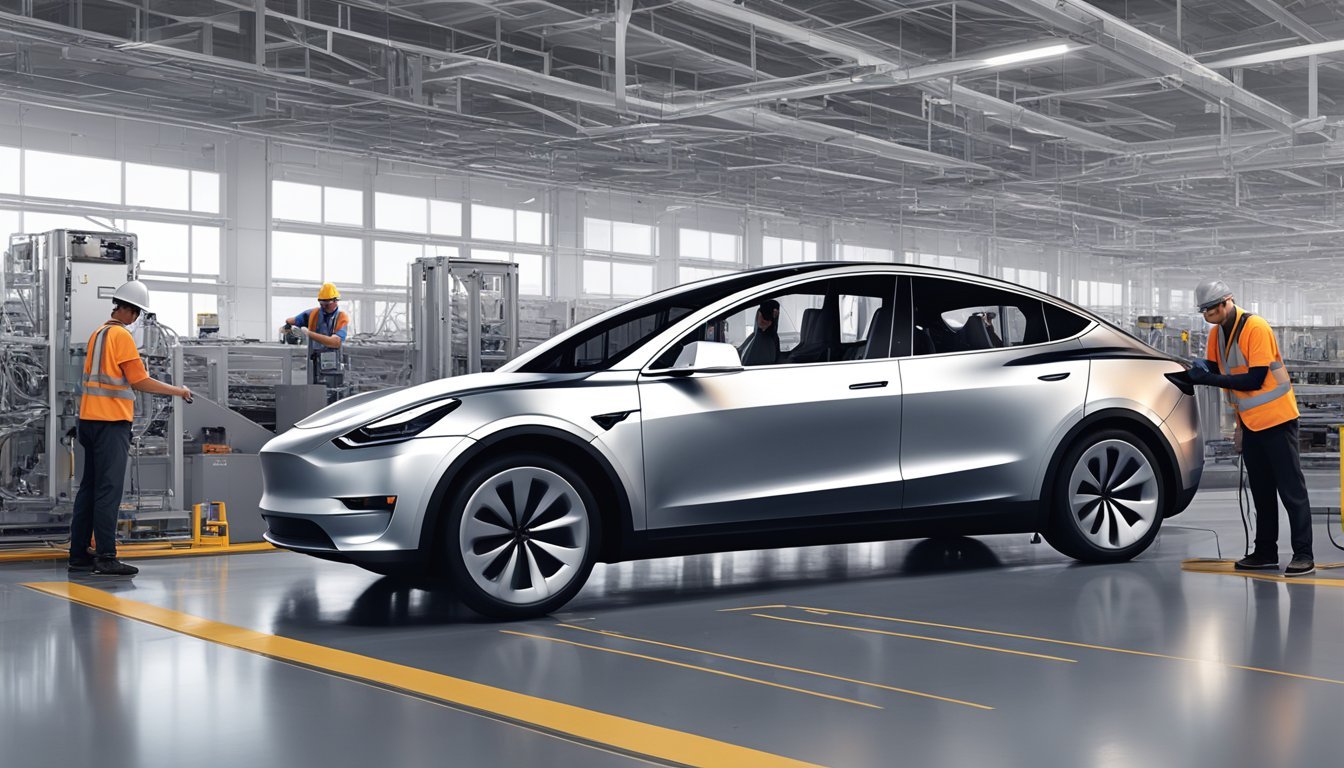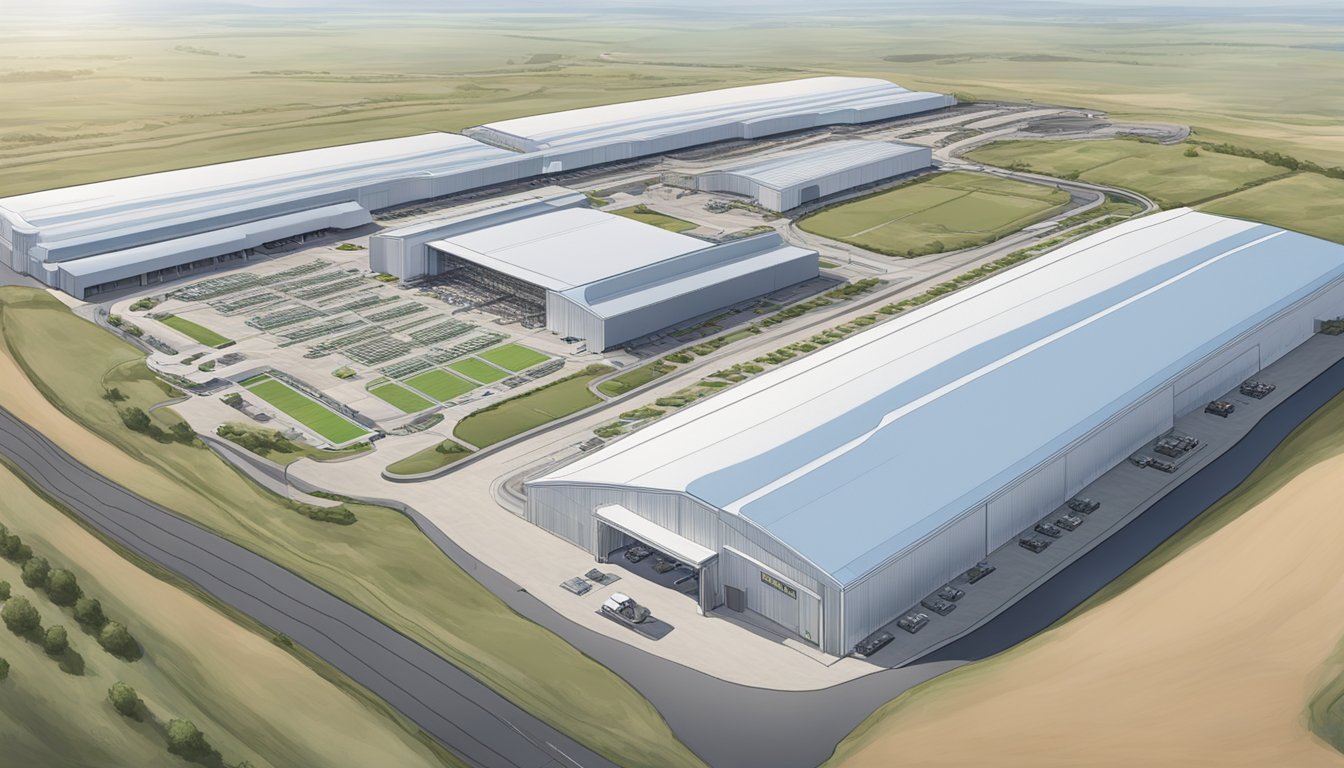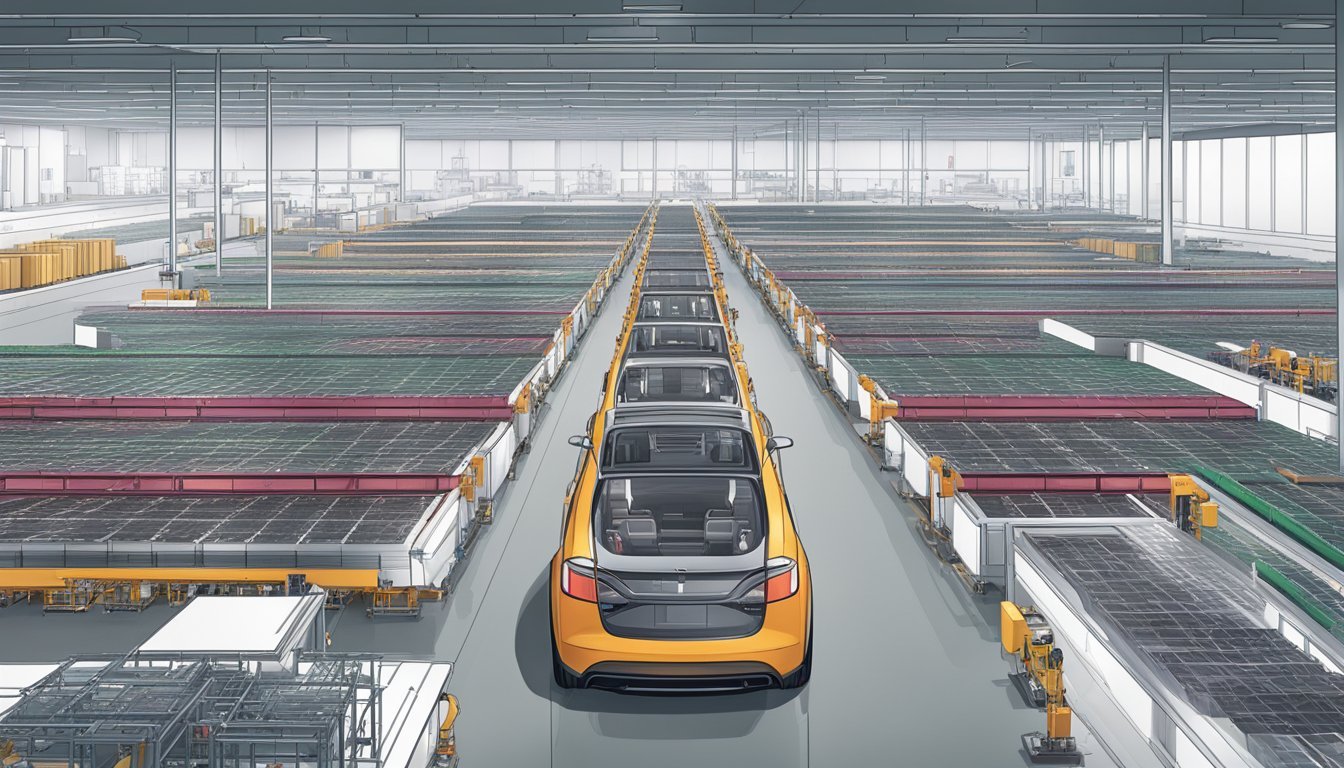Tesla Austin Battery Capacity: Giga Texas Powers Up with 4680 Cell Production!
Tesla's Giga Texas factory in Austin has become a focal point for the company's battery production efforts. The massive facility, spanning 2,500 acres along the Colorado River, serves as Tesla's global headquarters and a manufacturing hub for the Model Y and Cybertruck.
The Giga Texas plant is ramping up production of Tesla's advanced 4680 battery cells, with recent reports indicating significant progress. These cylindrical cells are a key component in Tesla's strategy to improve energy density and reduce costs in their electric vehicles.
While exact battery capacity figures for Giga Texas-produced vehicles remain undisclosed, estimates suggest impressive capabilities. The Tesla Cybertruck, for instance, is believed to feature a battery pack with approximately 123 kilowatt-hours of capacity. As production scales up, Tesla aims to manufacture over 6 gigawatt-hours of battery capacity annually at the Austin facility.
Overview of Tesla's Giga Texas
Tesla's Gigafactory Texas represents a significant milestone in the company's manufacturing capabilities and strategic expansion. The massive facility near Austin combines vehicle production and battery cell manufacturing under one roof.
Strategic Significance of Tesla Giga Texas
Giga Texas plays a crucial role in Tesla's plans to scale up production and meet growing demand. The factory's location provides logistical advantages for distributing vehicles across North America. It also serves as a hub for innovation, particularly in battery technology.
Tesla has invested heavily in the facility, with Elon Musk indicating it could reach $10 billion in total investment. This commitment underscores the factory's importance to Tesla's future growth and technological advancement.
Key Features and Facilities
The Gigafactory Texas boasts impressive production capabilities. It manufactures Model Y vehicles and is expected to produce the Cybertruck. The facility's 4680 battery cell production is a key highlight, with Tesla announcing the production of 50 million cells as of December 2024.
Production capacity at Giga Texas is substantial, with estimates suggesting it could produce up to 400,000 vehicles annually. The factory's battery production capabilities are equally impressive, potentially reaching over 6 GWh per year.
Giga Texas incorporates advanced manufacturing techniques and automation to maximize efficiency. Its integrated approach, combining vehicle assembly and battery production, streamlines the manufacturing process and reduces costs.
Battery Production at Giga Texas
Tesla's Giga Texas factory has made significant strides in battery production, particularly with its innovative 4680 cells. The facility has rapidly scaled up manufacturing while tackling various technical challenges.
Innovation in 4680 Battery Cell Technology
The 4680 battery cell represents a major leap in Tesla's battery technology. These larger, more energy-dense cells offer improved performance and efficiency compared to previous designs. Tesla engineers have optimized the cell's chemistry and structure to enhance power output and longevity.
Key features of the 4680 cells include a tabless design, which reduces internal resistance and improves thermal management. The cells also incorporate advanced materials that boost energy density and reduce production costs.
Tesla's focus on vertical integration allows for tighter quality control and faster iteration in cell development. This approach has accelerated the transition from prototype to mass production.
Scaling Up of Battery Production
Giga Texas has rapidly ramped up 4680 cell production. In June 2023, the factory hit a milestone of 10 million cells produced. By December 2024, that number had grown to 50 million cells.
This exponential growth demonstrates Tesla's commitment to high-volume manufacturing. The current production rate is estimated to support the creation of over 1,000 battery packs per week.
Tesla's production targets aim to reach several gigawatt-hours (GWh) of annual battery capacity. This scale is crucial for supporting the company's ambitious vehicle production goals, including the Cybertruck.
Challenges in Battery Manufacture
Despite impressive progress, Tesla faces ongoing challenges in battery production. Maintaining consistent quality across millions of cells is a complex task. The company must balance speed with precision in its manufacturing processes.
Supply chain management for raw materials remains a critical concern. Securing stable sources of lithium, nickel, and other key elements is essential for sustained production growth.
Tesla continues to refine its automation systems to improve efficiency and reduce defects. The transition from 2170-type cells to 4680 cells has required significant retooling and process adjustments throughout the production line.
Vehicle Production at Tesla Giga Texas
Tesla's Gigafactory in Austin, Texas has become a crucial manufacturing hub for the company's expanding vehicle lineup. The facility focuses on producing the Model Y and Cybertruck, with plans for additional models in the future.
Expanding Model Y Production
Tesla Giga Texas commenced Model Y production in April 2022. The factory initially focused on two variants of the popular electric SUV. Production capacity for the Model Y at this site has grown rapidly, reaching over 375,000 units annually.
This Austin-made Model Y features innovative 4680-type cylindrical battery cells and a structural battery pack. Tesla has made significant strides in battery production at Giga Texas, manufacturing millions of 4680 cells on-site.
The increased production volume of Model Y at Giga Texas has helped Tesla meet growing demand for electric vehicles in North America.
Tesla Cybertruck: Integration and Production
Giga Texas serves as the primary production site for Tesla's highly anticipated Cybertruck. The facility has been adapted to accommodate the unique manufacturing requirements of the electric pickup truck's stainless steel exoskeleton.
Tesla has invested in specialized equipment and production lines for Cybertruck assembly. The integration of Cybertruck production alongside Model Y has required careful planning and execution to optimize factory space and resources.
Initial production of the Cybertruck began in late 2023, with plans to ramp up volume throughout 2024 and beyond. Tesla aims to gradually increase Cybertruck output as manufacturing processes are refined and supply chains stabilized.
Road to Tesla Semi and Roadster
While Model Y and Cybertruck currently dominate production at Giga Texas, Tesla has outlined plans to expand its vehicle lineup at the facility. The Tesla Semi, an all-electric class 8 truck, is slated for future production at the Austin plant.
Preparations for Semi production include dedicated assembly areas and charging infrastructure to support the heavy-duty vehicle. Tesla continues to refine the Semi's design and production processes based on real-world testing and feedback.
The next-generation Roadster, Tesla's high-performance sports car, is also expected to be manufactured at Giga Texas in the coming years. The facility's advanced production capabilities and proximity to engineering teams make it an ideal location for Roadster assembly.
Infrastructure and Technology
Tesla's Giga Texas facility incorporates cutting-edge infrastructure and technology to advance battery production and vehicle manufacturing. The plant leverages innovative processes and equipment to streamline operations and boost efficiency.
Structural Battery Pack Integration
Tesla's 4680 battery cells form the core of its structural battery pack design. This approach integrates the battery directly into the vehicle chassis, enhancing rigidity and reducing weight. The Giga Texas plant has dedicated production lines for assembling these structural packs.
The facility recently achieved a milestone, producing 50 million 4680 cells on-site. This breakthrough demonstrates Tesla's progress in scaling up its battery technology. The structural pack design also simplifies vehicle assembly, potentially reducing production costs.
Drive Unit and Production Lines
Giga Texas houses advanced production lines for manufacturing electric vehicle drive units. These lines incorporate high levels of automation to ensure precision and consistency. Tesla's drive units integrate the motor, gearbox, and power electronics into a compact package.
The factory's layout optimizes material flow and production efficiency. Automated guided vehicles transport components between workstations. Tesla continues to refine its production processes, aiming to increase output and quality.
Robotaxi production capabilities are being integrated into the facility's infrastructure. This positions Giga Texas to support Tesla's future autonomous vehicle plans.
Sustainability and Innovation
Tesla's battery production at its Austin facility showcases advancements in energy storage technology and environmental stewardship. The company's focus on improving battery performance while reducing ecological impact demonstrates its commitment to sustainable manufacturing practices.
Energy Density and Efficiency
Tesla's 4680 battery cells, produced at the Austin Gigafactory, represent a significant leap in energy density. These cells store more power in a smaller package, enhancing the range and performance of electric vehicles. The improved design allows for better thermal management, reducing energy loss and increasing overall efficiency.
Tesla's continuous refinement of battery chemistry has resulted in cells that charge faster and last longer. This innovation extends the lifespan of battery packs, reducing the need for frequent replacements and conserving resources.
The company's vertical integration strategy, from raw material sourcing to cell production, enables tighter quality control and optimization of the entire battery manufacturing process.
Environmental Considerations
Tesla's Austin battery production facility incorporates sustainable practices to minimize its environmental footprint. The factory utilizes renewable energy sources, including on-site solar panels and energy storage systems, to power its operations.
Water conservation measures are implemented throughout the production process. Tesla employs closed-loop systems to recycle and reuse water, reducing overall consumption and strain on local resources.
The company has also invested in recycling technologies to recover valuable materials from end-of-life batteries. This circular approach helps reduce the demand for new raw materials and decreases waste.
Tesla's commitment to sustainability extends to its supply chain, working with partners to ensure responsible sourcing of battery materials and promoting ethical mining practices.
Global Expansion and Export Strategy
Tesla's Gigafactory Texas plays a crucial role in the company's international growth plans and export capabilities. The facility's strategic location and advanced manufacturingprocesses position it as a key player in Tesla's global production network.
Comparative Analysis with Other Gigafactories
Giga Texas shares similarities with Tesla's other Gigafactories but has unique attributes. Like Giga Shanghai and Giga Berlin, it focuses on vehicle and battery production. However, Giga Texas specializes in manufacturing 4680-type cylindrical cells, giving it an edge in battery technology.
The Austin facility's production capacity rivals that of Giga Shanghai, which can produce over 950,000 vehicles annually. Giga Texas aims to match or exceed this output. Its manufacturing capabilities include popular models like the Model Y and the innovative Cybertruck.
Compared to the Fremont factory in California, Giga Texas boasts more advanced automation and a larger footprint. This allows for higher efficiency and greater production volumes.
Giga Texas's Role as an Export Hub
Giga Texas serves as a vital export hub for Tesla's North American and global markets. Its central U.S. location provides logistical advantages for distributing vehicles across the continent.
The facility's proximity to major ports facilitates efficient shipping to international markets, particularly in Latin America and Europe. This strategic positioning helps Tesla reduce delivery times and transportation costs.
Giga Texas's focus on producing the Cybertruck and other high-demand models makes it a key source for fulfilling international orders. As Tesla expands its product lineup, the Austin Gigafactory's role in the company's export strategy is likely to grow even further.
Cultural and Economic Impact
Tesla's Gigafactory Texas has profoundly shaped Austin's economic landscape and cultural fabric. The facility's presence has sparked job growth, stimulated local businesses, and positioned the city as a hub for technological innovation.
Job Creation and Local Economy
Tesla's Gigafactory Texas has become Austin's largest private employer, with over 22,777 local employees. This massive workforce has injected significant economic vitality into the region. The factory's operations have created a ripple effect, supporting ancillary businesses and services.
Local suppliers and contractors have benefited from increased demand. Housing markets have seen growth as Tesla employees seek nearby residences. Restaurants, retail outlets, and service providers have experienced upticks in business.
Tesla's presence has also attracted other tech companies and startups to the area, further diversifying Austin's economy. The company's $469 million wage contribution has bolstered local spending power and tax revenues.
Community Engagement and Brand Image
Tesla has actively engaged with the Austin community, fostering goodwill and strengthening its brand image. The company has launched scholarship programs for local engineering students, demonstrating its commitment to nurturing local talent.
Training initiatives across various disciplines have helped upskill the local workforce. These programs not only benefit Tesla but also enhance the overall employability of Austin residents.
The "Cyber Rodeo" event, marking the Gigafactory's opening, showcased Tesla's ability to blend its high-tech image with local culture. This celebration highlighted the company's integration into Austin's unique identity.
Tesla's focus on sustainable manufacturing aligns with Austin's environmental goals, enhancing the city's reputation as a green technology hub. The Gigafactory's production of electric vehicles and advanced battery technology has positioned Austin at the forefront of the clean energy transition.







